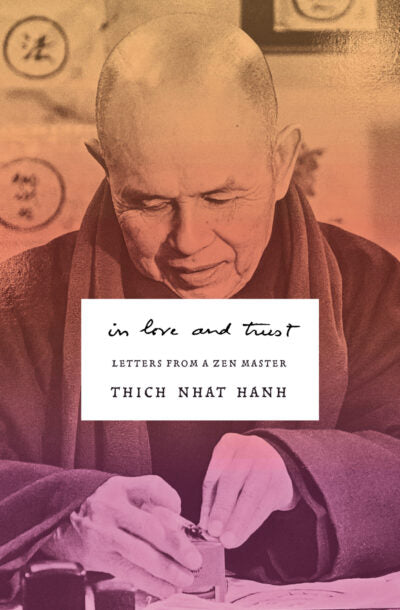Parallax Press
In love and Trust
In love and Trust
Couldn't load pickup availability
In Love & Trust: Letters from a Zen Master
In Love and Trust: Letters From A Zen Master is published on October 15th, 2024 by Parallax Press.
It offers a striking look at Thich Nhat Hanh as seen through his intimate letters to monastics, lay practitioners, allies in the peace movement, and other friends on the path. Through these touching pieces of correspondence, we see Thich Nhat Hanh at his warmest and most inspirational, at his most candid and direct. These personal messages of love and trust demonstrate the deeply human origins of Thầy’s teachings—and Thầy’s own deeply human expression of them.
In Love and Trust is composed primarily of newly translated letters, presented in English for the first time. The book features archival photos and Thich Nhat Hanh’s own handwriting throughout.
Letter writing as a practice
For Zen Master Thich Nhất Hạnh, whom I (Sister Dinh Ngheim) and others affectionately called “Thầy” or “teacher” in Vietnamese, letter writing was an art, a deep practice of awareness and connection, and an important channel for him to transmit his love for his students. Thầy knew that, by sitting down and writing a letter, he could express intimacy, care, and his full attention; he was able to com municate his insight and his energy in a heartfelt and lasting way.
Thầy had many students, and he wanted to understand each one. However, in a community as large as the Plum Village monastic sangha—composed of monks and nuns from monasteries and practice centers around the world—it would have been impossible for each monastic to meet with Thầy one-on-one. Letter writing became a vital thread connecting Thầy to his large monastic family. But even when the community was quite small, Thầy encouraged us to write to him. He likely understood that we could let ourselves be more vulnerable through our writing, that we could write things down that we were too shy to tell him face to face. In our letters to Thầy, we could reveal deep joys and deep suffering directly from our hearts, sometimes for the first time.
Even though Thầy suggested we write to him from the very early days of our monastic community, we never expected to receive a personal letter from Thầy. I remember the first time he wrote to us—we were so happy, so surprised! We each received a photocopy of that and subsequent letters, and these copies remain dear to many of us—we cherish them and keep them safe to this day.
Over the years, I have enjoyed reading these letters many times, whenever I need some energy to inspire my practice or a reminder of Thầy’s deep love for his students. We’re happy to share many of these most cherished letters with you in this book. Thầy often wrote to us when something significant happened in the community, or when he felt like we needed some inspiration.
Vitamins for the Sangha
That first letter, for instance, came during a summer retreat in Plum Village, France. Even though the long annual summer retreat is a very joyful time of year, it is also the most exhausting period for the monastic community. Thầy saw clearly that he could boost our energy by writing to us during these busy stretches; after he noticed how much his first letter helped, he began writing to us regularly during each summer retreat.
We often said that these letters were like vitamins for us during those weeks of hard and loving work! As we see in the letters included here, Thầy felt deeply responsible for his community’s energy and capacity for practice. Our collective harmony and vitality were his top priorities.
Of course, Thầy’s deep practice of letter writing precedes the formation of his monastic community. He loved writing letters to lay students and reading their letters to him; he learned so much from lay friends’ letters about lay life, about each letter writer’s unique difficulties, and about critical social or political circumstances or events.
Indeed, as the letters in this book illustrate, letter writing played a vital role in Thầy’s engaged social action right from the beginning. Thầy read and reflected deeply on every letter he received from his students, lay or monastic, and he usually made sure that the letter writer received guidance; even if Thầy didn’t follow up directly, he’d identify a lay or monastic teacher to help that person through their difficulty. Thầy often responded to a letter he’d received by incorporating his reflections into a Dharma talk, or by offering a talk on a particular topic. This is why many people in the audience felt that Thầy was speaking directly to them about their unique suffering. In a sense, he was speaking directly to that person, because he truly received each letter writer’s deepest sufferings, aspirations, and joys, bringing those elements with him into the talks that he gave.
Share


